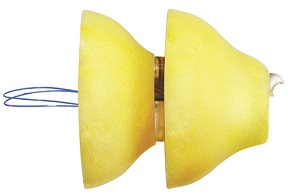New Phonak technology enables more natural sound – 94% of users would recommend Lyric to a friend or loved one.
Orlando, Florida / Staefa, Switzerland (March 26, 2014) – From the very beginning, Phonak Lyric has been unique: It is the only hearing aid that is 100% invisible and can be worn 24 hours a day 7 days a week, for months at a time*, and without requiring the hassles of changing batteries. A convincing concept: 94% of the Lyric users would recommend Lyric to their friends and beloved ones1. And it is even getting better: Featuring the latest Phonak technology – a low-power, deep-ear chip for enhanced signal processing – the new Lyric generation brings a more natural hearing experience to users, and improved programming flexibility to Lyric partners.
Lyric is only 12 mm long and sits completely invisible deep inside the ear canal – 24/7, for months at a time. It uses the outer ear’s natural anatomy to direct sound to the device, where it is amplified to the eardrum. As a result of Lyric’s placement, users experience improved directionality2 and localization3, and the majority of Lyric wearers report that the sound quality is very natural. No wonder that 88% of Lyric users report that communication has improved with friends and family, and that even 94% would recommend it to friends or loved ones4.

The new Lyric generation: latest Phonak technology for more natural sound quality and improved programming flexibility.
The latest Lyric generation can do even more – both for people with mild-to-moderate hearing loss and hearing care professionals. “Lyric has been a huge success from the very beginning, and the user satisfaction rates speak for themselves”, says Maarten Barmentlo, Group Vice President Marketing of Phonak. “Lyric is now fully integrated into the Phonak portfolio, and we have listened intently to our partners and end-users to take this great concept to the next level. We are proud to present the result of these efforts: the latest Phonak technology ensures that Lyric offers not only natural sound quality, but also improved programming flexibility to ensure an enhanced Lyric experience.”
Some of the latest Lyric generation’s unique benefits include:
- Next generation low-power, deep-ear chip that enables enhanced adaptive signal processing
- Adaptive signal and compression processing to provide clean, natural and undistorted sound in a variety of listening situations
- Expanded gain range with per-patient amplification configuration
- Ergonomic and easy-to-use programming wand that allows for independent, binaural programming at the ear
- Improved pre-calc based on NAL and over 14,000 audiograms
- New programming options and software interface to provide increased fitting flexibility
“Lyric is a great addition to each hearing care professional’s portfolio and offers huge business potential, “explains Maarten Barmentlo. “Addressing a new target audience and achieving outstanding satisfaction rates among patients, the new Lyric offers unique growth and differentiation potential.”
About Phonak
Headquartered near Zurich, Switzerland, Phonak, a member of the Sonova Group, has developed, produced and globally distributed state-of-the-art hearing systems and wireless devices for more than 60 years. The combination of expertise in hearing technology, mastery in acoustics and strong cooperation with hearing care professionals allows Phonak to significantly improve people’s hearing ability and speech understanding and therefore their quality of life.
Phonak offers a complete range of digital hearing instruments, along with complementary wireless communication systems. With a worldwide presence, Phonak drives innovation and sets new industry benchmarks regarding miniaturization and performance.
For more information, please visit www.phonakpro.com or the Phonak Expo Page on AudiologyOnline.
* Individual replacement needs may vary. Duration of device battery life varies by patient and is subject to individual ear
conditions.
[1] Based on a telephone survey of 100 patients who have used Lyric for at least 30 days.
[2] Blauert, J. (1997). Spatial Hearing: The Psychophysics of Human Sound Localization. MIT Press, Cambridge, MA, p. 63.â ¨
[3] Langendijk, E.H.A. and Bronkhorst, A.W. (2002). Contribution of spectral cues to human sound localization. Journal of the Acoustical Society of America, 112, 1583-1596.
[4] Based on a telephone survey of 100 patients who have used Lyric for at least 30 days.

